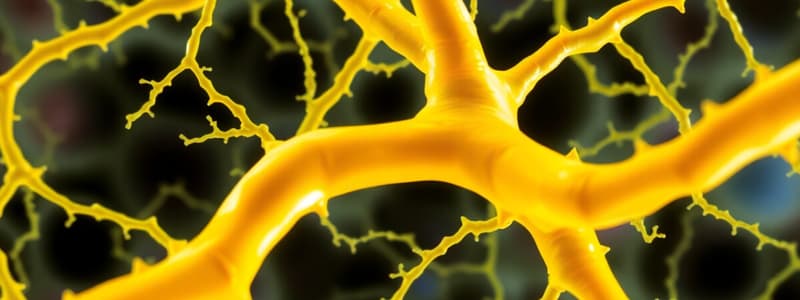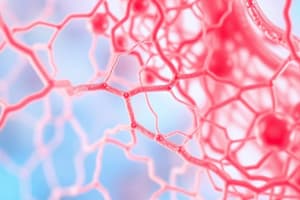Podcast
Questions and Answers
What primarily characterizes the composition of connective tissues?
What primarily characterizes the composition of connective tissues?
- High ratio of cells to matrix
- High ratio of extracellular matrix to cells (correct)
- Mostly composed of epithelial cells
- Equal ratio of cells to matrix
Which of the following is a function performed by connective tissue?
Which of the following is a function performed by connective tissue?
- Regeneration of nerve cells
- Direct nutrient absorption
- Protection against pathogens
- Mechanical support (correct)
What role does the extracellular matrix play in connective tissues?
What role does the extracellular matrix play in connective tissues?
- It provides structural and functional features specific to different tissues. (correct)
- It acts as a primary energy source for cells.
- It only serves to isolate and protect cells.
- It enhances the metabolic rate of cells.
In which connective tissue is energy storage primarily associated?
In which connective tissue is energy storage primarily associated?
What term refers to the overproduction of collagen during wound healing in connective tissues?
What term refers to the overproduction of collagen during wound healing in connective tissues?
What is required for the degranulation of mast cells?
What is required for the degranulation of mast cells?
What type of fibers are known to provide tensile strength greater than steel?
What type of fibers are known to provide tensile strength greater than steel?
Which component of ground substance serves as a physical barrier against infection?
Which component of ground substance serves as a physical barrier against infection?
What type of fibers are described as long, thin, and capable of stretching and recoiling?
What type of fibers are described as long, thin, and capable of stretching and recoiling?
What is the primary role of fibroblasts in connective tissue?
What is the primary role of fibroblasts in connective tissue?
Which type of collagen is primarily found in cartilage?
Which type of collagen is primarily found in cartilage?
What is the primary function of reticular fibers?
What is the primary function of reticular fibers?
Which cells are responsible for the synthesis of elastic fibers?
Which cells are responsible for the synthesis of elastic fibers?
What is a distinguishing feature of loose irregular connective tissue (LICT)?
What is a distinguishing feature of loose irregular connective tissue (LICT)?
Which type of collagen is known for forming the basement membrane?
Which type of collagen is known for forming the basement membrane?
Which type of macrophage is found in the alveoli of the lungs?
Which type of macrophage is found in the alveoli of the lungs?
What is the main function of plasma cells?
What is the main function of plasma cells?
What type of granules do mast cells contain?
What type of granules do mast cells contain?
In which organ would you find fixed macrophages primarily?
In which organ would you find fixed macrophages primarily?
Which cell type can be classified as a connective tissue basophil?
Which cell type can be classified as a connective tissue basophil?
What defines the lifespan of macrophages that are associated with tattoos?
What defines the lifespan of macrophages that are associated with tattoos?
What role do macrophages in the central nervous system play?
What role do macrophages in the central nervous system play?
The granules of which type of mast cell are present in the lamina propria of the gastrointestinal tract?
The granules of which type of mast cell are present in the lamina propria of the gastrointestinal tract?
Which of the following types of connective tissue is considered embryonic?
Which of the following types of connective tissue is considered embryonic?
What is the predominant cell type found in loose connective tissue?
What is the predominant cell type found in loose connective tissue?
Which of the following describes mesenchymal cells?
Which of the following describes mesenchymal cells?
What characterizes dense connective tissue?
What characterizes dense connective tissue?
What are the primary components of the extracellular matrix?
What are the primary components of the extracellular matrix?
How does the arrangement of fibers differ in connective tissues?
How does the arrangement of fibers differ in connective tissues?
Which of the following is a characteristic of wandering cells in connective tissue?
Which of the following is a characteristic of wandering cells in connective tissue?
What is the main function of glycosaminoglycans in the extracellular matrix?
What is the main function of glycosaminoglycans in the extracellular matrix?
What is the primary characteristic of dense regular connective tissue?
What is the primary characteristic of dense regular connective tissue?
Which tissue is described as being tough and able to resist tension from any direction?
Which tissue is described as being tough and able to resist tension from any direction?
Where is adipose tissue primarily located?
Where is adipose tissue primarily located?
Which of the following connective tissues provides a supporting framework for hemopoietic organs?
Which of the following connective tissues provides a supporting framework for hemopoietic organs?
Which connective tissue is known for insulation and storing energy?
Which connective tissue is known for insulation and storing energy?
Flashcards
Connective Tissue Function
Connective Tissue Function
Connective tissues support, exchange metabolites, store energy, and participate in inflammation and wound healing.
Components of Connective Tissue
Components of Connective Tissue
Connective Tissues are mainly composed of extracellular matrix with embedded cells.
Extracellular Matrix
Extracellular Matrix
The non-cellular component of connective tissues, made mostly by the cells in the tissues.
Connective Tissue Matrix Composition
Connective Tissue Matrix Composition
Signup and view all the flashcards
Connective Tissue Function: Support
Connective Tissue Function: Support
Signup and view all the flashcards
Mesenchyme
Mesenchyme
Signup and view all the flashcards
Connective Tissue Classification
Connective Tissue Classification
Signup and view all the flashcards
Loose Connective Tissue
Loose Connective Tissue
Signup and view all the flashcards
Dense Connective Tissue
Dense Connective Tissue
Signup and view all the flashcards
Fixed Cells (Connective Tissue)
Fixed Cells (Connective Tissue)
Signup and view all the flashcards
Wandering Cells (Connective Tissue)
Wandering Cells (Connective Tissue)
Signup and view all the flashcards
Extracellular Matrix (ECM)
Extracellular Matrix (ECM)
Signup and view all the flashcards
Fibrillar Proteins (ECM)
Fibrillar Proteins (ECM)
Signup and view all the flashcards
Mast Cell Degranulation
Mast Cell Degranulation
Signup and view all the flashcards
Ground Substance
Ground Substance
Signup and view all the flashcards
Glycosaminoglycans (GAGs)
Glycosaminoglycans (GAGs)
Signup and view all the flashcards
Types of Collagen Fibers
Types of Collagen Fibers
Signup and view all the flashcards
Fibroblast
Fibroblast
Signup and view all the flashcards
Macrophage Locations
Macrophage Locations
Signup and view all the flashcards
Plasma Cell Function
Plasma Cell Function
Signup and view all the flashcards
Plasma Cell Structure
Plasma Cell Structure
Signup and view all the flashcards
Mast Cell Granules
Mast Cell Granules
Signup and view all the flashcards
Mast Cell Location
Mast Cell Location
Signup and view all the flashcards
Mast Cell Release
Mast Cell Release
Signup and view all the flashcards
Mast Cell Characteristics
Mast Cell Characteristics
Signup and view all the flashcards
Macrophage-Monocyte Link
Macrophage-Monocyte Link
Signup and view all the flashcards
Dense Connective Tissue: Regular
Dense Connective Tissue: Regular
Signup and view all the flashcards
Dense Connective Tissue: Irregular
Dense Connective Tissue: Irregular
Signup and view all the flashcards
Adipose Tissue
Adipose Tissue
Signup and view all the flashcards
Reticular Connective Tissue
Reticular Connective Tissue
Signup and view all the flashcards
Mucoid Tissue
Mucoid Tissue
Signup and view all the flashcards
Collagen Types
Collagen Types
Signup and view all the flashcards
Collagen Synthesis
Collagen Synthesis
Signup and view all the flashcards
What is Gelatin?
What is Gelatin?
Signup and view all the flashcards
Elastic Fiber Properties
Elastic Fiber Properties
Signup and view all the flashcards
Reticular Fiber Composition
Reticular Fiber Composition
Signup and view all the flashcards
Study Notes
Connective Tissues
- Connective tissues are primarily composed of extracellular elements and a limited number of cells. They are abundant and widely distributed throughout the body.
- They are derived from mesenchyme
- The extracellular matrix is primarily secreted by cells embedded within it. Its composition varies between different tissues, impacting their structure and function.
- Examples of connective tissues include blood, bone, cartilage, and various types of connective tissue proper.
General Features of Connective Tissue
- Cells: A variety of cells, including fibroblasts, mesenchymal cells, adipocytes, macrophages, and various blood cells act as fixed or wandering agents in different connective tissues.
- Matrix: The matrix is composed of fibers (e.g., collagen, elastic, reticular fibres) and ground substance.
- Fibers: Provide structural support and strength.
- Ground substance: A gel-like substance containing water, salts, glycosaminoglycans (GAGs), proteoglycans, and glycoproteins. It helps with nutrient and waste diffusion within the tissues.
Classification of Connective Tissues
- Connective tissue proper: This includes loose (areolar) and dense (regular and irregular) connective tissue. Specialized forms of connective tissue proper include adipose (fat) tissue and reticular tissue.
- Supporting connective tissues: This category contains cartilage and bone. These provide structural support and form the framework of various tissues and organs.
- Fluid connective tissue: This includes blood, which transports nutrients, gases, and waste products.
Function of Connective Tissues (CT)
- Mechanical support: CT provides mechanical support to organs and epithelia, acts as a supporting tissue for the organs.
- Metabolite exchange: CT facilitates the exchange of metabolites within tissues.
- Energy storage: Adipose tissue functions to store energy, insulates and support in mechanical functions.
- Inflammation: CT provides a site of action for blood-borne immune cells involved in inflammatory responses.
- Wound healing: Fibrosis, an overproduction of collagen, is involved in wound healing.
Cell Types in Connective Tissue
- Fibroblasts: Specialized cells that produce extracellular fibers and ground substance.
- Mesenchymal cells: Undifferentiated cells with the capacity to differentiate into other connective tissue cells.
- Adipocytes (fat cells): Cells specialized for storing lipids, found in adipose tissue.
- Macrophages: Cells involved in phagocytosis (engulfing and digesting foreign particles).
- Plasma cells: Cells responsible for antibody production.
- Mast cells: Cells involved in allergic reactions and inflammation, and contain histamine or heparin. Lymphocytes and leukocytes are also found in some connective tissues.
Fibres of Connective Tissues
- Collagen fibers: Strongest and most abundant, providing tensile strength to the tissues. They are arranged in bundles, and their structure contributes to tensile strength.
- Elastic fibers: These allow for stretching and recoil of tissues like those found in ligaments, blood vessels and skin.
- Reticular fibers: Fine collagenous fibers forming delicate networks that support soft tissues like spleen, lymph nodes, and bone marrow providing support.
Extracellular Matrix (ECM)
- The ECM is primarily composed of ground substance and fibers, secreted by cells.
- Glycosaminoglycans (GAGs), proteoglycans, glycoproteins contribute to the ground substance, providing vital properties of viscosity, support and diffusion.
- Fibrous elements contribute to the structure and tensile strength of connective tissues.
Studying That Suits You
Use AI to generate personalized quizzes and flashcards to suit your learning preferences.




